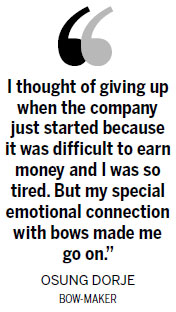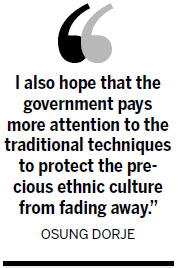Bows handmade by local craftsman Osung Dorje were welcomed by athletes at the third biennial Five Colorful Holy Arrows International Ethnic Archery Invitational Tournament in Jainca county in Qinghai province.
Jainca is known as an archery town, where in the past every family had bows and taught their children to shoot. Making bows with buffalo horns was popular in the county but the skill nearly died out.
The art of making the bows is now an intangible cultural heritage of Huangnan Tibetan autonomous prefecture in the province. The skill survived thanks to the efforts of Osung Dorje.
"Bows and arrows were the only toys in our childhood," the 47-year-old told Xinhua News Agency. "There were no shops selling bows, so we had to make them ourselves."
He said that his uncle taught him the traditional craft and when he was 24 he left home for Lhasa in Tibet, where he met a bow maker called Tsultrim. Osung Dorje said that Tsultrim made cheap bows for children and was silent when he worked.
"It seemed that Tsultrim did not make bows just for money, but for a holy belief," he said. "His concentration was very impressive and it was then that I wanted to go back home to make bows for the first time."
During Spring Festival in his hometown in 2008, Osung Dorje's friend told him that after many deaths of old bow-making masters it was tough to buy bows in "the town of archery".
He decided to stay, start a company and make bows, but it took him a month to make his first one.
"I thought of giving up when the company just started because it was difficult to earn money and I was so tired," he said. "But my special emotional connection with bows made me go on."
Making traditional buffalo horn bows is a complicated process, he said. Each of the seven procedures must be carefully handled or the entire bow can fail. Osung Dorje said that his profits were "far less" than when he did business in Lhasa.
"A high-quality bow often takes half a year to finish," said Osung Dorje. "We prepare the materials in winter, and make dozens of bows the next summer."
"Ramming and ripping the tendons are two difficult procedures," he said. "We ram the tendons flat after they dry in the shade, and then rip them apart. Few people master the techniques."
Osung Dorje said that sourcing materials was a problem, as it was difficult to find 45-70 cm-long buffalo horns and the correct tendons.
The bow-maker, whose son became handicapped after he suffered an electric shock at the age of six, decided to help other disabled people by teaching them how to make bow parts so they could become suppliers.
His company trained 12 handicapped people last year and organizes regular training programs so that the traditional skill "can be spread wider", he said. "Many handicapped people are very diligent, and they can make the components very well."
"I hope my company will expand so I can teach more handicapped or unemployed people to make bows," he told Xinhua. "And I also hope that the government pays more attention to the traditional techniques to protect the precious ethnic culture from fading away."
zhangzhao@chinadaily.com.cn


(China Daily 09/24/2014 page17)


